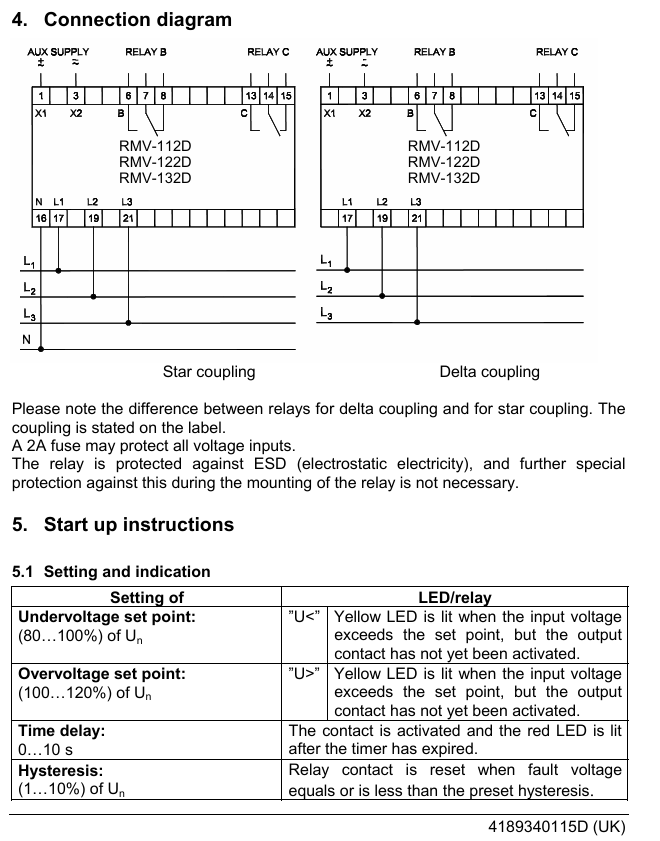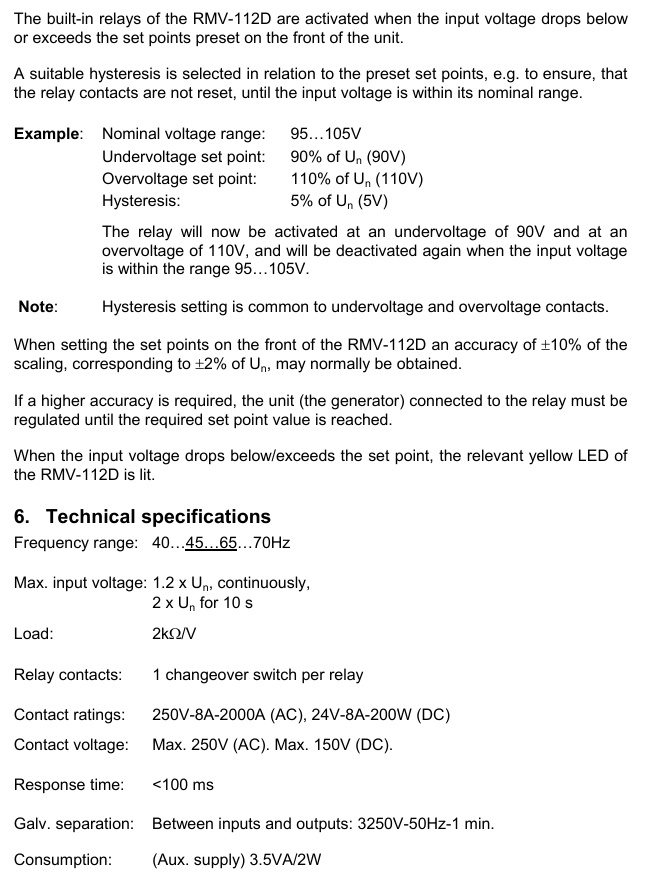

K-WANG


DEIF RMV-111D undervoltage and overvoltage relay
DEIF RMV-111D undervoltage and overvoltage relay
Product core positioning
RMV-111D is a combined undervoltage and overvoltage relay in the "uni line" series of DEIF company, mainly used for the protection and control of generators. Through three-phase voltage detection, it achieves dual protection of undervoltage (U<) and overvoltage (U>), and is equipped with functions such as timed tripping and fault status LED indication to ensure voltage stability of the power generation system.
Product identification and key information (label content)
The relay comes with a label that indicates the core parameters, which is a key basis for contacting the manufacturer and confirming the configuration, including:
Basic model: RMV-112D (e.g. example label: TYPE RMV-112D 121120).
Measurement and power supply parameters: measurement voltage (such as 230V/400V), voltage module specifications (such as MODULE 230V), auxiliary power supply voltage (such as 24VDC), wiring method (star "STAR" or triangle "DELTA", example label includes "COUPLING DELTA").
Special configurations: delay time, special calibration values, etc. (pre-set by DEIF).
Compliance and labeling: CE certification, installation category (such as CAT III), maximum voltage to ground, dealer number (to be filled in by the dealer).
Relay characteristics: Label the action mode of the relay (such as "RELAY NORM. ENERGY" normally energized type, "LATCH" latch function), the latch circuit needs to disconnect the power supply voltage and reset, even if the input returns to normal, the contacts will still remain in the alarm position.
Note: The relay is equipped with a 200ms power on/off protection circuit: the normally energized contact (NE) does not operate within 200ms after power on to ensure stable function; Monitor the voltage within 200ms after power failure to avoid misjudgment.

Installation instructions
1. Installation method and specifications
Installation type: Supports panel installation, can be fixed on a 35mm DIN rail, or directly installed with 2 4mm screws.
Weight: Approximately 0.650kg.
Spacing requirement: It can be installed in close proximity to other "uni line" series units, but the distance between the relay and other devices/relays must be ≥ 50mm.
Rail placement: If multiple relays are installed on the same DIN rail, the rail must be placed horizontally.
2. Wiring precautions
Wiring differences: It is necessary to distinguish between star (STAR) and delta (DELTA) wiring methods. The specific wiring method should be marked on the product label, and refer to the "Connection diagram" for operation.
Voltage protection: All voltage input terminals can be connected in series with 2A fuses to prevent overcurrent damage.
Static protection: The relay comes with ESD (electrostatic discharge) protection, and no additional anti-static measures are required during installation.
Startup and parameter settings
1. Core parameter setting and indication
Set key parameters through the front knob of the relay and provide feedback on the status with LED lights. The specific correspondence is as follows:
Range of parameter settings: LED/relay action feedback
When the input voltage is lower than the set value (U<) and the rated voltage (U ₙ) is 80%~100%, the corresponding yellow LED will light up (the contact is not activated at this time); After the delay is over, the contact will activate and the red LED will light up
When the input voltage is higher than the set value, the yellow LED of "U>" will light up (at this time, the contact is not activated) when the overvoltage setting value (U>) is 100%~120% of the rated voltage (U ₙ); After the delay is over, the contact will activate and the red LED will light up
After a delay of 0-10s, the relay contacts will activate and the red LED will light up
Hysteresis: 1%~10% of the rated voltage (U ₙ) of the hysteresis value is shared by undervoltage/overvoltage. When the fault voltage drops/rises to within the hysteresis value, the relay contacts reset
2. Set examples (to help understand)
Assuming rated voltage range (U ₙ): 95~105V
Undervoltage setting value: 90% of U ₙ (i.e. 90V)
Overvoltage setting value: 110% of U ₙ (i.e. 110V)
Return difference: 5% of U ₙ (i.e. 5V)
The relay is activated when the voltage is ≤ 90V (under voltage) or ≥ 110V (over voltage); When the voltage returns to the range of 95-105V, the contacts reset.
3. Accuracy Description
Front knob setting accuracy: usually ± 10% of the scale, corresponding to ± 2% of the rated voltage (U ₙ).
Higher precision requirement: It is necessary to adjust the equipment connected to the relay (such as the generator) until the target set value is reached.
Technical specifications
Category specific parameters
Frequency range 40~45~65~70Hz
Continuous maximum input voltage: 1.2 × U ₙ; 10s short-term maximum input: 2 × U ₙ
Load requirement of 2k Ω/V
Relay contact: 1 transfer switch for each relay; Rated values: AC 250V-8A-2000A, DC 24V-8A-2000W; Maximum voltage: AC 250V, DC 150V
Response time<100ms
Electrical isolation between input and output: 3250V (50Hz), lasting for 1 minute
Auxiliary power consumption 3.5VA (apparent power)/2W (active power)

- YOKOGAWA
- Energy Access
- Renewable Integration
- Energy Subsidies
- Energy and Water
- Net zero emission
- Energy Security
- Critical Minerals
- A-B
- petroleum
- Mine scale
- Energy and Gender
- Covid-19
- man-machine
- Reliance
- ADVANCED
- SEW
- ProSoft
- WATLOW
- Kongsberg
- FANUC
- VSD
- DCS
- PLC
- Sewage treatment
- cement
- Yaskawa
- Woodward
- BOSCH Rexroth
- MOOG
- General Electric
- American NI
- Rolls-Royce
- CTI
- Honeywell
- EMERSON
- Automobile market
- xYCOM
- Motorola
- architecture
- Industrial information
- New energy
- electricity
- Construction site
- HIMA
- ABB
- Rockwell
- Schneider Modicon
- Siemens
- MAN
- GE
- TRICONEX
- Control Wave
- ALSTOM
- AMAT
- STUDER
- KONGSBERG
- MOTOROLA
- DANAHER MOTION
- Bentley
- Galil
- EATON
- MOLEX
- Triconex
- DEIF
- B&W
- ZYGO
- Aerotech
- DANFOSS
- KOLLMORGEN
- Beijer
- Endress+Hauser
- schneider
- Foxboro
- KB
- REXROTH
- YAMAHA
- Johnson
- Westinghouse
- WAGO
- TOSHIBA
- TEKTRONIX
- BENDER
- BMCM
- SMC
-
GE Hydran M2-X Enhanced Monitoring
-
ABB REG316 1mrk000809-GA Numerical Generator Protection
-
ABB RED670 1MRK004810 Line differential protection
-
GE SR750-P5-G5-S5-HI-A20-R-E Feeder protection system
-
ABB PFTL301E-1.0KN 3BSE019050R1000 PillowBlock Load cells
-
Kollmorgen S33GNNA-RNNM-00 - Brushless Servo Motor
-
Kollmorgen 6sm56-s3000-g-s3-1325 - Servo Motor
-
Kollmorgen AKM52K-CCCN2-00 - Servo Motor
-
Kollmorgen PSR3-230/75-21-202 - Power Supply
-
Kollmorgen akm24d-anc2r-00 - Servo Motor
-
Kollmorgen AKM22E-ANCNR-00 - Servo Motor
-
Kollmorgen S60300-550 - Servo Drive
-
Kollmorgen B-204-B-21 - Servomotor
-
Kollmorgen AKM21E-BNBN1-00 - Servo Motor
-
Kollmorgen TT2953-1010-B - DC Servo Motor
-
Kollmorgen pa8500 - Servo Power Supply
-
Kollmorgen BDS4A-210J-0001-207C2 - Servo Drive
-
Kollmorgen TTRB1-4234-3064-AA - DC Servo Motor
-
Kollmorgen MH-827-A-43 - Servo Motor
-
Kollmorgen AKM24D-ACBNR-OO - Servo Motor
-
Kollmorgen 00-01207-002 - Servo Disk DC Motor
-
Kollmorgen AKM21C-ANBNAB-00 - Servo Motor
-
Kollmorgen PSR3-208/50-01-003 - Power Supply
-
Kollmorgen 6SM56-S3000 - Servo Motor
-
Kollmorgen DBL3H00130-B3M-000-S40 - Servo Motor
-
Kollmorgen 6SN37L-4000 - Servo Motor
-
Kollmorgen AKM65K-ACCNR-00 - Servo motor
-
Kollmorgen 6SM56-L3000-G - Servo Motor
-
Kollmorgen AKMH43H-CCCNRE5K - Servo Motor
-
Kollmorgen PSR4/52858300 - Power Supply
-
Kollmorgen KBM-79H03-E03 - Direct Drive Rotary Motor
-
Kollmorgen AKM33E-ANCNDA00 - Servo Motor
-
Kollmorgen U9M4/9FA4T/M23 - ServoDisc DC Motor
-
Kollmorgen AKM13C-ANCNR-00 - Servo Motor
-
Kollmorgen AKM43L-ACD2CA00 - Servo Motor
-
Kollmorgen AKM54K-CCCN2-00 - Servo Motor
-
Kollmorgen M-605-B-B1-B3 - Servo Motor
-
Kollmorgen AKD-P00606-NBAN-0000 - Rotary Drive
-
Kollmorgen 6SM-37M-6.000 - Servo Motor
-
Kollmorgen A.F.031.5 - Sercos Interface Board
-
Kollmorgen 918974 5054 - Servo PWM
-
Kollmorgen U12M4 - ServoDisc DC Motor
-
Kollmorgen AKD-B00606-NBAN-0000 - Servo Drive
-
Kollmorgen MV65WKS-CE310/22PB - Servo Drive
-
Kollmorgen 65WKS-CE310/22PB - Servo Drive
-
Kollmorgen EM10-27 - Module
-
Kollmorgen S64001 - Servo Drive
-
Kollmorgen CR03200-000000 - Servo Drive
-
Kollmorgen 6SM57M-3000+G - Servo Motor
-
Kollmorgen BDS4 - Servo Drive
-
Kollmorgen AKD-P00306-NBEC-000 - Servo Drive
-
Kollmorgen AKD-B01206-NBAN-0000 - Servo Drive
-
Kollmorgen STP-57D301 - Stepper Motor
-
Kollmorgen 6SM37L-4.000 - Servo Motor
-
Kollmorgen 44-10193-001 - Circuit Board
-
Kollmorgen PRDR9SP24SHA-12 - Board
-
Kollmorgen PRD-AMPE25EA-00 - Servo Drive
-
Kollmorgen DBL3N00130-0R2-000-S40 - Servo Motor
-
Kollmorgen S406BA-SE - Servo Drive
-
Kollmorgen AKD-P00607-NBEI-0000 - Servo Drive
-
Kollmorgen AKD-P01207-NBEC-0000 - Servo Drive
-
Kollmorgen CR03550 - Servo Drive
-
Kollmorgen VSA24-0012/1804J-20-042E - Servo Drive
-
Kollmorgen N2-AKM23D-B2C-10L-5B-4-MF1-FT1E-C0 - Actuator
-
Kollmorgen 04S-M60/12-PB - Servo Drive
-
Kollmorgen H33NLHP-LNW-NS50 - Stepper Motor
-
Kollmorgen A-78771 - Interlock Board
-
Kollmorgen AKM43E-SSSSS-06 - Servo Motor
-
Kollmorgen AKD-P00607-NBEC-0000 - Servo Drive
-
Kollmorgen E21NCHT-LNN-NS-00 - Stepper Motor
-
Kollmorgen cr10704 - Servo Drive
-
Kollmorgen d101a-93-1215-001 - Motor
-
Kollmorgen BDS4A-203J-0001-EB202B21P - Servo Drive
-
Kollmorgen MCSS23-6432-002 - Connector
-
Kollmorgen AKD-P01207-NACC-D065 - Servo Drive
-
Kollmorgen CK-S200-IP-AC-TB - I/O Adapter and Connector
-
Kollmorgen CR10260 - Servo Drive
-
Kollmorgen EC3-AKM42G-C2R-70-04A-200-MP2-FC2-C0 - Actuator
-
Kollmorgen BDS5A-206-01010-205B2-030 - Servo Drive
-
Kollmorgen s2350-vts - Servo Drive
-
Kollmorgen AKM24D-ANC2DB-00 - Servo Motor
-
Kollmorgen E31NCHT-LNN-NS-01 - Stepper Motor
-
Kollmorgen PRD-0051AMPF-Y0 - Servo Board
-
Kollmorgen TB03500 - Module
-
Kollmorgen 60WKS-M240/06-PB - Servo Drive
-
Kollmorgen M21NRXC-LNN-NS-00 - Stepper Motor
-
Kollmorgen H-344H-0212 - Servo Motor
-
Kollmorgen MCSS08-3232-001 - Connector
-
Kollmorgen AKM33H-ANCNC-00 - Servo Motor
-
Kollmorgen PA-2800 - Power Supply
-
Kollmorgen MTC308C1-R1C1 - Servo Motor
-
Kollmorgen PRDR0091300Z-00 - Capacitor Board
-
Kollmorgen BDS4A-206J-0024/01502D79 - Servo Drive
-
Kollmorgen S20330-VTS - Servo Drive
-
Kollmorgen S20250-CNS - Servo Drive
-
Kollmorgen SBD2-20-1105-WO - Servo Drive Board
-
Kollmorgen M405-C-A1--E1 - Servo Motor
-
Kollmorgen PRD-PB805EDD-00 - Servo Drive
-
Kollmorgen 6SM57S-3.000-J-09-HA-IN - Servo Motor
-
Kollmorgen AKM33H-ANCNDA-00 - Servo Motor
-
Kollmorgen PCB-00030200-04 - PCB
-
Kollmorgen H22SSLB-LNN-NS-02 - Stepper Motor
-
Kollmorgen BJRL-20012-110001 - Module
-
Kollmorgen BDS4A-206J-0001404A - Servo Drive
-
Kollmorgen H-342-H-0802 - Servo Motor
-
Kollmorgen CR10561 - Servo Drive
-
Kollmorgen BDS5A-206-00010-205B2-030 - Servo Drive
-
Kollmorgen BDS5A-206-00010-207B-2-030 - Servo Drive
-
Kollmorgen mcss08-3224-001 - Connector
-
Kollmorgen M-207-B-23-B3 - Servo Motor
-
Kollmorgen PRD-0041200Z-S0 - Encoder/Resolver Card
-
Kollmorgen MH-225-G-61 - Motor
-
Kollmorgen MT308B1-T1C1 - Servo Motor
-
Kollmorgen BDS4A-240J-0001604C83 - Servo Drive
-
Kollmorgen 6SM57-S-3000 - Servo Motor
-
Kollmorgen N-T31V-15-5B-6-MF3-FT1E-C251 - Actuator
-
Kollmorgen PRD-0051AMPA-X0 - Servo Board
-
Kollmorgen CF-SS-RHGE-09 - Cable
-
Kollmorgen DIGIFAS7204 - Servo Drive
-
Kollmorgen S30101-NA - Servo Drive
-
Kollmorgen DIGIFAS7201 - Servo Drive
-
Kollmorgen PRD-0051AMPA-Y0 - Servo Board
-
Kollmorgen AKM23D-EFCNC-00 - Servo Motor
-
Kollmorgen SE10000 - Servo Drive
-
Kollmorgen PSR4/5A-112-0400 - Power Supply
-
Kollmorgen AKM31H-ANCNC-01 - Servo Motor
-
Kollmorgen M-203-B-93-027 - Servo Motor
-
Kollmorgen CP-SS-G1HE-05 - Connector




